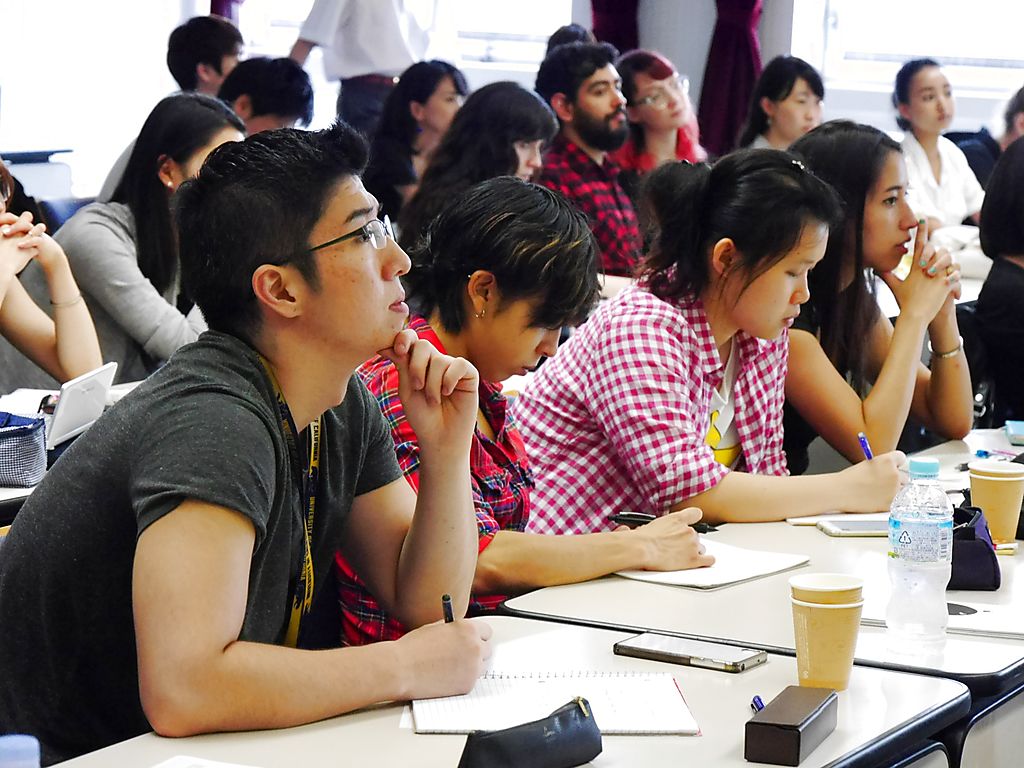Writers and scholars discuss global art and diasporic art in Japan and Asia
Thu, Jul 2, 2015-
Tags
Techniques of Diaspora and Internationalism:
An interdisciplinary look into creative practice
A symposium on global art and diasporic art in Japan and Asia
On July 1, The School of International Liberal Studies (SILS) and New York University’s Asian/Pacific/American Institute hosted a symposium on the emergence, transformations, and diversifications of Asian diasporic cultural productions in the context of transcultural, transnational, and global mobilities. The symposium featured presentations from fiction writer and director of NYU Buenos Aires, Anna Kazumi Stahl, independent writer and artist, Erika Kobayashi, and Professor of East Asian Studies at NYU, Tom Looser. The symposium offered participants an opportunity to look into Japanese diasporic and transnational creative techniques by exploring overlapping themes between literary creations and visual cultural productions through interdisciplinary approaches. The concluding event of the 2015 Global Asia/Pacific Art Exchange (GAX) organized by NYU’s Asian/Pacific/American Institute in collaboration with the Mori Art Museum, this symposium was a point of departure toward the 2017 Global Asia/Pacific Art Exchange symposium to be held in Buenos Aires, Argentina. Contemplating several questions about connotations of the Asian diasporic experience and interdisciplinary theories in regards to literary creations and visual cultural productions, the symposium encouraged participants to think about the prospects and challenges of interdisciplinary approaches to Asian diasporic cultural productions.

Anna Kazumi Stahl is an exophonic writer, or someone who writes in a non-native language. Stahl has written many novels in Spanish such as Flores de un solo dia.
Following opening remarks from Waseda professor, Waseda Institute of Latin American Studies researcher, and symposium organizer Shigeko Mato, Anna Kazumi Stahl gave a presentation entitled “Fragmentaria: Diasporic Experience and Narratives of Self.” Stahl began her presentation by examining the origin and meaning of “diaspora.” “Inside the word I am so curious because that dia is ‘about’ or ‘across’ and that speirein in the Greek root is ‘to scatter’ but it is also to ‘to sow’ as in to throw out seeds onto fertile ground,” said Stahl. “So in a sense diaspora is about ‘seed time,’ la siembra.” Stahl continued to examine how this word is used to convey ‘dispersal’ from an origin, and questioned why we tend to think of this origin as only one.

Stahl shares a photo from her childhood while discussing lines of division within the Japanese-American community
Daughter of a Japanese mother from Kyoto and a German-American father, Stahl recalled her experiences as a Japanese-American in New Orleans, Louisiana in the 1960s and 70s, a time fraught with inter-racial conflict, and as a Japanese-American in 21st century Buenos Aires, Argentina. “[In Lousiana] I have this recollection of how absolutely isolated we were. We’ve got two or three children from reckless white families coming to our birthday parties. There’s an odd orientalism in the recklessness of those families because they knew my mother and were interested in her flower arranging….and wondered how they could make it keep for a week.” Stahl discussed lines of division she observed between generations within the Japanese-American community as well as lines of separation between Japanese and Japanese-Americans at the local consulate’s New Year’s banquets – lines of separation that could be felt within the community but invisible to those outside of it. Stahl discussed how these experiences influence her creative process and have led to works such as Flores de un solo dia, a novel that deals with the subject of identity in relation to a protagonist caught between wanting and not wanting to find out what lurks in her family history.

Many students and guests attended the symposium to hear from presenters
Following Stahl’s presentation, writer, artist, and nominee of the 2014 Akutagawa prize and Yukio Mishima prize, Erika Kobayashi, gave a presentation on her creative process when writing the novels Breakfast with Madame Cruie and Children of Light: Luminous, a story that traces the history of the atom and of radiation. She also discussed the autobiographical Your Dear Kitty which is based on the diaries of her father and Anne Frank. When asked about her research process, Kobayashi commented how it is not unusual for her to research a particular interest for ten years before writing about it.

Erika Kobayashi
The final presentation of the symposium from Tom Looser of NYU was entitled “The Techniques of Diasporic Hope” and examined the aesthetic, cultural, social, and political context of art in relation to contemporary imagery of islands and diaspora in Asia and Japan. Beginning with the concept of ‘nations’ within the framework of classical modernity, Looser asked, “What is a diaspora if the nation itself no longer holds so much weight as the space of identity in our world and what is a diaspora in the just now developing forms of globalization?” Looser continued to discuss the emergence of diasporic, island-style communities which “float in their new context but are nonetheless somewhat rooted in their original location or homeland” and how this ‘island’ imagery is seen in the work of contemporary artists such as Masakatsu Sashie and Manabu Ikeda, and in the film Avatar.

Tom Looser discusses ‘island’ imagery and diasporic art and global art












